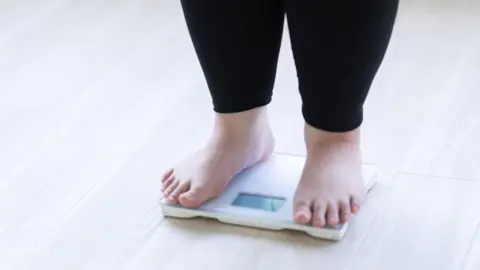Child obesity clinics seeing BMIs over 50
 Getty Images
Getty ImagesA disproportionate number of children referred to NHS excess weight clinics in England are from the most deprived areas, and a significant number are neurodivergent or have other health conditions, a study has found.
Some have a body mass index (BMI) over 50, with 40 deemed to be severely obese.
Nearly 4,800 under-18s have been referred to the clinics since they were set up in 2021, according to research carried out by Leeds Beckett, Sheffield Hallam, Leeds and Bristol universities and presented at the European Congress on Obesity.
The clinics provide mental health support and care for other underlying conditions, as well as dietary advice.
Specialist excess weight clinics treat severely obese children in England aged 2-17, who are flagged as needing help by their GP or another doctor.
The clinics are run by multi-disciplinary teams including paediatricians, psychologists and dieticians.
The new research, which looked at 32 of the clinics, found that over 40% of the children attending them lived in the most deprived neighbourhoods.
Based on data from more than 3,000 child patients, many had other health conditions:
- 24% had autism
- 23% a learning disability
- 30% had liver disease
- a significant proportion had another health complication
Professor Simon Kenny, national clinical director at NHS England, said he was "shocked" by the challenges that the young people faced when he met them and their families.
"I became aware of the fact that this an invisible problem because they so rarely get out of the house.
"That means they are not attending school, they are not interacting with their peer group," Prof Kenny said.
He explained that living with excess weight can cause problems affecting every organ system. Poor school attendance can also affect future employment and life opportunities.
"The NHS won't just sit by and let children and young people become ill adults," he said.

Some of the specialist clinics are using digital technology for weight loss support. For example, children can use 'smart scales' at home which do not show their weight. The data is connected to a mobile app to show the trend without the numbers. Only clinicians are able to see the data and provide feedback to the family.
Tam Fry, chair of the National Obesity Forum, while welcoming the use of technology, said: "They should have been doing this years ago."
He said there hadn't been enough emphasis on routine weighing and measuring.
"This should be done at regular intervals and due note taken of the trend. There are graphs from child health records which are not used. Children arrive at school in an unfit condition and that's often too late," Mr Fry added.
In another paper presented to the European Congress on Obesity, presented by Dr Annika Janson from Karolinska University Hospital in Sweden, researchers said giving weight loss jabs to children could be effective.
She said that trials of the drugs in children aged 12 and over had shown a loss of 5-16% of body weight after a year, but added it was "difficult to isolate the effect of adding GLP-1 drugs to the plethora of treatments that are already available".
The medicines regulator NICE has not approved weight loss drugs for routine use by children in England, although they can be provided by specialists if there is urgent clinical need.
What does BMI mean?
Body mass index (BMI) is widely used as a simple way of finding out whether a person is a healthy weight for their height.
For adults:
a BMI of 18.5 to 24.9 is considered to be a healthy weight
a BMI of 25 to 29.9 is considered to be overweight
a BMI over 30 is considered to be obese
But it's not accurate for everyone because it can't tell the difference between fat and muscle, and doesn't take into account ethnic background.
Your waist circumference may be a better guide.
